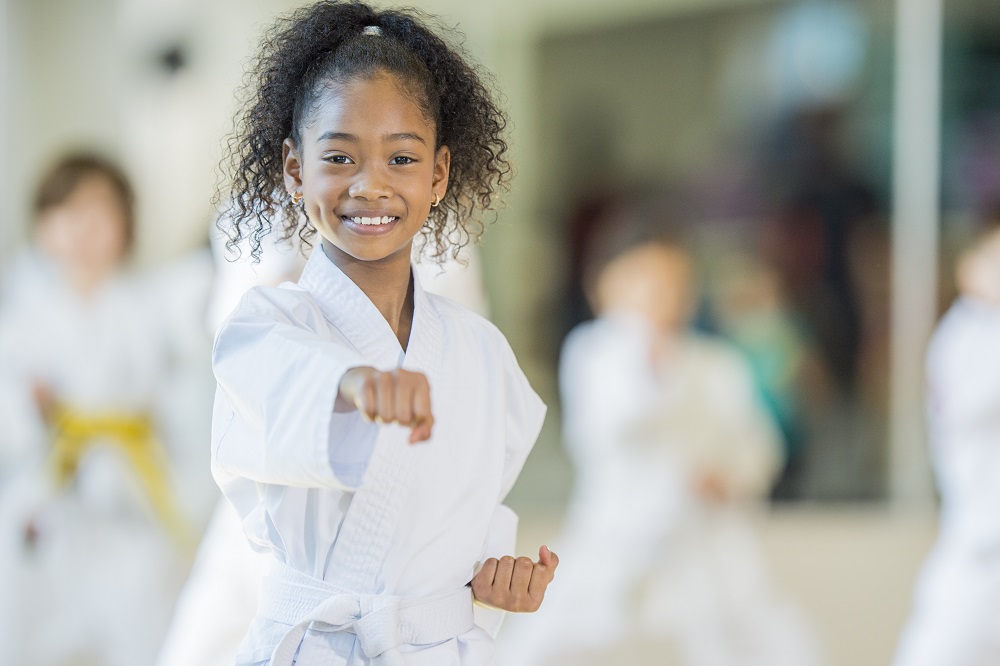Martial arts don’t just improve the mental and physical health of adults, they also provide distinct advantages during a child’s development.
We look at the mental and physical benefits of martial arts for children.
Self-confidence
Mastering the various martial arts techniques is no easy feat and can work wonders for a child’s confidence levels. When a child reaches a new level it gives them a sense of accomplishment that is vital for their self-esteem and mental development.
For some children, it may be the first time in their life that they’re setting and achieving a measurable goal. They therefore gain the necessary attributes to defend themselves should the need ever arise and get an endorphin rush in the process.
Discipline
Martial arts are ideal for instilling a sense of discipline in a child in a number of ways. Firstly, it gives them emotional control and allows them to set personal boundaries. Acting recklessly on the mats will significantly hamper their progress, so by practising martial arts they’ll quickly get to grips with how to control their emotions and channel them in a positive way.
They’ll also master the art of seeing a challenge through to its conclusion. This requires complete concentration, an understanding of their weaknesses and what motivates them to accomplish a set target. Finally, they’ll learn to follow a set of rules, which can only benefit them in the classroom.
Decision-making
Success is often the result of good decision-making – and martial arts are useful for helping a child develop their decision-making skills. While sound decision-making understandably doesn’t come naturally to children, martial arts expand their ability to judge and react to a situation.
For example, if they’re grappling, they need to decide quickly which move to execute to gain an advantage over their opponent. In both an educational and social setting, this decisiveness under pressure will prove invaluable for their development.
Respect
Martial arts demand the highest levels of mutual respect among their practitioners. From the minute a child walks into a dojo, they must follow strict social etiquette when interacting with their instructors and their peers. Whether it’s bowing to their masters or supporting other students, practitioners are expected to show respect at every opportunity.
By showing respect all times, they help each other achieve a common goal as they learn a new life skill. What’s more, learning to work as part of a team is essential for being in a workplace environment later in life.
Focus
The complexity of martial arts systems means that a great deal of teaching is required before they are put into practice. As such, listening and concentration skills are put to the test when it comes to mastering martial arts.
At a young age, a child is likely to have a relatively low attention span. This is why getting them to learn the importance of listening to, remembering and carrying out instructions is essential. There are few better activities than martial arts to help them achieve this, even if they’ve had problems focusing in the past. As an example, karate has been proven to alleviate the symptoms of Attention Deficit Hyperactivity Disorder (ADHD).
Social skills
Throughout their lives, children will find themselves in unfamiliar environments among people they don’t know. Therefore, taking part in martial arts training as part of a group prepares them for this challenge.
The earlier they can adjust to new surroundings, the easier it will become for them to interact with others. Not only will children learn about teamwork through practising martial arts, they will discover the true value of friendship. They will also develop communication skills, which can be difficult for children who are naturally shy or have behavioural problems.
Balance
Children spend a lot of time hunching, whether they’re in front of the computer screen or playing video games. This means they need to spend time working on their balance and posture – and guess what can help with that?
Standing or exercising on one leg is a classic martial arts balance training technique, as are the ‘air kicks’ we see on TV and in movies. Achieving good balance at an early age will give a child a healthy posture later in life. It will also help them avoid problems such as muscle weakness and breathing difficulties when they get older.
Co-ordination
Martial arts systems rely heavily on hand-eye and foot-eye coordination, two physical traits children will use throughout their lives. Being co-ordinated will ensure they are less susceptible to injuries and are aware of how to use their body effectively.
Some of the best martial arts moves to enhance coordination are the chamber for a kick or the angle of a fist. These repetitions teach a child how to move, and where they should position themselves. With greater coordination comes greater confidence in your physical ability, which reiterates both the physical and mental advantages of martial arts.
General health
It won’t surprise you to learn that fitness and strength are key requirements of martial arts.
Warm-ups with jumping jacks, push-ups and stretches all work the core muscles and cardiovascular system. Along with the movements themselves, of course. From underutilised muscle groups, to fast-twitch muscle fibres, martial arts engages numerous key parts of the body.
Having a solid core and good cardiovascular health will build a strong foundation for a child, by enabling them to stabilise and align their body. While they don’t need to look like Bruce Lee just yet, the health benefits provided by martial arts will help set them on the way to a long and healthy life.
Whether you’re training with children or adults, if you’re a martial arts instructor you need specialist martial arts insurance. Find out more about our martial arts insurance or get an instant online quote with us today.





Leave a Reply